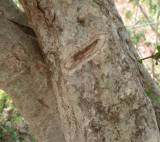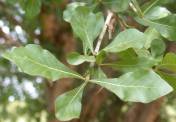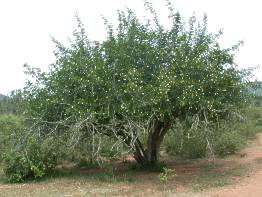Gardenia cornuta
Gardenia cornuta Hemsl.
Family: Rubiaceae
Common names: Tonga gardenia, Natal gardenia, horned gardenia (Eng.); wilde-appel, Tongakatjiepiering, Natalkatjiepiering (Afr.); umhlahle, unomphumela, umvalasangweni (Zulu)
SA Tree No: 690.1
Introduction
The spectacular, large white and yellow flowers with their sweet scent, attracts passersby from a distance to this small, much-branched tree. The smooth, glossy, golden yellow fruits add to this spectacle in the bushveld, thicket, woodland and on grassy plains.

Description
Description
Gardenia cornuta is a shrub or multi-branched small tree, 3 to 5 m tall, with erect and spreading main branches, branchlets sometimes with thick thorns, a trunk that is whitish grey, the bark is smooth, often flaking into thin peels.

Leaves are smooth and crowded at the ends of twigs, usually in whorls of three, light glossy green, short-stalked, 20-30 mm long and broad, margins smooth; stipules joined to form a ring around the node.

Flowers are solitary at the ends of short, rigid branches, borne in summer, November to March, white turning yellow, short-stalked, with a long, slender greenish tube, 50-60 mm, and spreading white lobes, 20-30 mm long. The calyx is very unusual, with 6 long, narrow lobes arising from its sides and not at its apex. Fruits which are more attractive than the flowers, are more or less pear-shaped, woody, tipped with persistent remains of the calyx, glossy golden yellow, 40-50 x 30-35 mm, usually produced in large quantities between February and August. Seeds are hard and flattened.
Conservation Status
Status
Gardenia cornuta is not threatened, just like all other species in this genus.
Distribution and habitat
Distribution description
Gardenia cornuta is found in the bushveld, woodland, grassy plains and thicket in Zululand, Maputaland, the extreme southeastern Mpumalanga, Swaziland and southern Mozambique. It is very decorative when in flower and fruit and best for gardens that are in frost-free areas.

Derivation of name and historical aspects
History
The genus name Gardenia was named after Alexander Garden, a medical doctor and naturalist from South Carolina. The species name cornuta, means horned; perhaps referring to the remnants of the persistent calyx lobes of the fruit. This species was first collected in 1870 but it was only after 35 years that it was eventually described in 1906. The genus Gardenia has about 60 species in tropical and warm parts of the Old World, seven in southern Africa. It has no representatives in the Northern and Western Cape.
Ecology
Ecology
The long, slender flower tube and the white, sweetly scented flowers suggest that insects like moths and butterflies pollinate this plant. Fruits are eaten by monkeys and inyala, it seems therefore reasonable to assume that seeds are dispersed by these animals. Leaves are browsed by goats and game.
Uses
Use
Decorative fruiting branches placed in a vase may remain fresh for up to month, since branches are able to absorb water readily. In traditional medicine, fruit and roots are boiled and used as an emetic. Poles are used for fencing around the homestead and for fuel.

Growing Gardenia cornuta
Grow
This very neat and decorative small tree is best suited for a spot in the garden where it will stand alone so that it gets all the attention it deserves, more especially when in flower. It should be propagated from fresh seed. Sow seeds in flat seedling trays filled with river sand. Once seedlings have produced three leaves, transplant them into small nursery plastic bags filled with well-drained mixture. When the seedlings are big enough, they must be transplanted into bigger bags from where they can be planted out after a couple of weeks.
This plant needs a well-drained area in a garden where the seedling can be protected from cold winds. Since it is not widely found in gardens, it is difficult to know if it has any pests. Gardenia thunbergia is another attractive species, worthy of cultivation.
References
- Glen, H.F. 2004. SAPPI What's in a name? Jacana, Johannesburg.
- Leistner, O.A. 2000. Seed plants of southern Africa : families and genera. Strelitzia 10. National Botanical Institute, Pretoria.
- Palmer, E. & Pitman, N. 1972. Trees of southern Africa. Balkema, Cape Town.
- Phillips, E.P. 1943. Gardenia cornuta. The Flowering Plants of South Africa 23. Botanical Research Institute, Pretoria.
- Pooley, E.S. The complete field guide to trees of Natal, Zululand and Transkei. Natal Flora Publications Trust, Durban.
- Schmidt, E., Lotter, M. & McCleland, W. 2002. Trees and shrubs of Mpumalanga and Kruger National Park. Jacana, Johannesburg.
- Venter, F. & Venter, J.-A. 1993. Making the most of indigenous trees, no. 39. Farmer's Weekly
Credits
Mkhipheni Ngwenya
KwaZulu-Natal Herbarium
June 2005
Plant Attributes:
Plant Type: Shrub, Tree
SA Distribution: Gauteng, KwaZulu-Natal, Limpopo, Mpumalanga
Soil type: Sandy, Loam
Flowering season: Early Summer, Late Summer
PH: Acid, Neutral
Flower colour: White, Yellow
Aspect: Full Sun, Morning Sun (Semi Shade), Afternoon Sun (Semi Shade)
Gardening skill: Average
Special Features:
Horticultural zones









Rate this article
Article well written and informative
Rate this plant
Is this an interesting plant?
Login to add your Comment
Back to topNot registered yet? Click here to register.